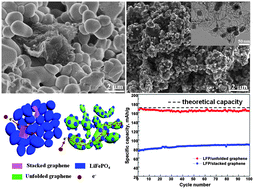LiFePO4–graphene as a superior cathode material for rechargeable lithium batteries: impact of stacked graphene and unfolded graphene†
Abstract
In this work, we describe the use of unfolded

* Corresponding authors
a
Department of Mechanical and Materials Engineering, University of Western Ontario, London, ON, N6A 5B9 Canada
E-mail:
xsun@eng.uwo.ca
Tel: +1 519 661-2111 ext. 87759
b Department of Chemistry, University of Western Ontario, London, ON, N6A 5B7 Canada
c Clariant (Canada), 1475, rue Marie-Victorin, St-Bruno, QC, J3V 6B7 Canada
In this work, we describe the use of unfolded

 Please wait while we load your content...
Something went wrong. Try again?
Please wait while we load your content...
Something went wrong. Try again?
J. Yang, J. Wang, Y. Tang, D. Wang, X. Li, Y. Hu, R. Li, G. Liang, T. Sham and X. Sun, Energy Environ. Sci., 2013, 6, 1521 DOI: 10.1039/C3EE24163G
To request permission to reproduce material from this article, please go to the Copyright Clearance Center request page.
If you are an author contributing to an RSC publication, you do not need to request permission provided correct acknowledgement is given.
If you are the author of this article, you do not need to request permission to reproduce figures and diagrams provided correct acknowledgement is given. If you want to reproduce the whole article in a third-party publication (excluding your thesis/dissertation for which permission is not required) please go to the Copyright Clearance Center request page.
Read more about how to correctly acknowledge RSC content.
 Fetching data from CrossRef.
Fetching data from CrossRef.
This may take some time to load.
Loading related content
